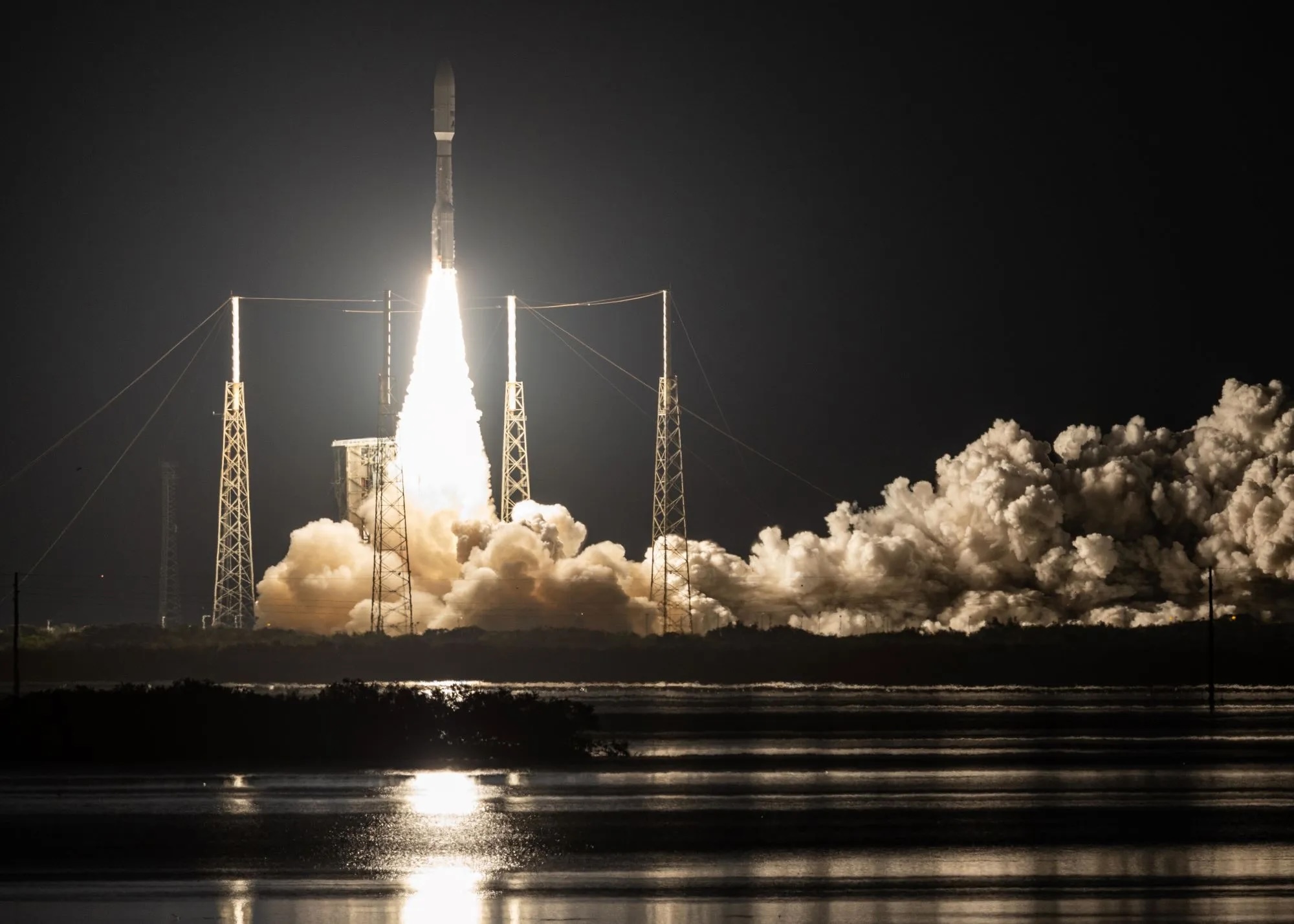24.10.2025

Viasat nears launch of VS-3 F2 satellite aboard ULA Atlas V rocket
Viasat is poised to soon launch its much-anticipated ViaSat-3 Flight 2 (VS-3 F2) satellite aboard a United Launch Alliance Atlas V 551 rocket from Cape Canaveral Space Force Station in Florida.
Once VS-3 F2 is online — around “mid- to end of Q1” calendar year 2026 — and Viasat starts bringing up its services, the Ka-band geostationary satellite is expected to more than double the bandwidth capacity of the firm’s entire existing fleet, Don Buchman, vice president and general manager of Viasat’s Commercial Aviation business told Runway Girl Network.
It will initially support both aviation and residential markets in the Americas.
According to United Launch Alliance (ULA), the spacecraft has successfully completed standalone launch site testing, been mated to the launch vehicle payload adapter, and has now been encapsulated in the payload fairing in preparation to join its Atlas V rocket later this week.
ULA said:
The launch of a United Launch Alliance (ULA) Atlas V 551 rocket carrying the ViaSat-3 Flight 2 (F2) mission for Viasat is planned for no earlier than Monday, Nov. 3, 2025, pending range approval.
The launch is scheduled for 10:36 p.m. EST at the opening of a 44-minute window, from Space Launch Complex-41 at Cape Canaveral Space Force Station, Florida.
The VS-3 constellation is comprised of three Ka-band GEO satellites, each designed to be capable of rapidly shifting capacity throughout its coverage area to deliver bandwidth where and when it’s needed most. The first satellite, VS-3 F1, suffered a reflector deploymentproblem which dramatically reduced its capacity to less than 10%. Thereafter, Viasat engaged in a lot of the root cause analysis, simulations and physical testing of the VS-3 F2 satellite to remedy any potential weakness.
“The design was strengthened throughout,” said Buchman.
He told Runway Girl Network Viasat has “very high confidence” that any issues have been addressed.
Despite the VS-3 F1 anomaly, Viasat has put the remaining capacity to good use in the aviation market, with passenger surveys showing the satellite is supporting a “phenomenal quality” of service on the southwest U.S.-Hawaii routes where it is in play, Buchman said.
“It’s a game changer,” he said, and airlines can expect the same when VS-3 F2 is in service.
Initially, with VS-3 F2, “residential will be served, and aero; those are kind of your two big markets,” he said. Thereafter, other markets — maritime, energy and fixed enterprise — are expected to be addressed.
Living in a rural area, your author once explored Viasat’s residential plans, but when it came time to buy, the plans were no longer on offer in my area. That’s because, after the VS-3 F1 anomaly, Viasat focused its F1 capacity on aviation. “We don’t oversell,” Buchman noted, so VS-3 F2 will “unlock that problem you ran into. So, we’ll start that engine back up.”
He noted:
What’s really important is the flexibility it brings. When you think of traditional satellites it’s essentially fixed capacity on the ground with not a lot of flexibility… you had to know where your demand is.
With ViaSat-3, the capacity follows the demand.
We’ve seen really good examples in the North Atlantic, so when you go from U.S. to Europe, you get weather patterns and wind patterns and the entire flight patterns will shift hundreds of miles north or south and so that shifts away from where the density of your capacity is… all the aircraft will be now outside of your densest areas, and your capacity doesn’t follow the demand. And so, with ViaSat-3, when we talk about flexibility, that’s what we’re talking about is it follows the demand, instead of having to predict where the demand is at.
And so that’s the flexibility that we’ve really seen play out just with a limited mission with F1 that we redeployed. So, we’re probably 16 months into launching airlines on that, and it’s performing phenomenally.
With ViaSat-3 satellites offering flexible capacity — and the forthcoming VS-3 F3 satellite expected to do the same for Asia-Pacific routes — Viasat’s older static assets become more valuable, Buchman suggested. The ViaSat-1 satellite, for instance, has fixed beams over the eastern third of the United States and some western states. “So that will allow us to, with this flexible capacity, get the best use of both, such that we can actually amplify the production of those older assets when they’re coupled with these new assets, like ViaSat-3 coming in.”
In the United States, Viasat counts American Airlines, Delta Air Lines, JetBlue Airways and Southwest Airlines among its inflight connectivity customers. United Airlines is also a customer, though it is in the process of fitting SpaceX’s Starlink LEO satcom solution to its fleet. VS-3 F2 provides an opportunity for Viasat to expand within its base and add more customers, especially as operators adopt the free Wi-Fi model, and as that adoption spreads globally, Buchman told RGN.
The high-capacity asset will also help airlines to unlock more operational benefits via the cabin connectivity pipe. “I think you’ll start seeing a lot more data being driven by the crew and in the aircraft itself,” Buchman said.
In the meantime, there’s great excitement at Viasat’s offices in Carlsbad, California as VS-3 F2 nears its launch from Cape Canaveral.
Quelle: Runway Girl Network
----
Update: 14.11.2025
.
ULA launches ViaSat-3 following valve replacement on Atlas 5 rocket

A United Launch Alliance Atlas 5 551 rocket lifts off from Space Launch Complex 41 (SLC-41) at Cape Canaveral Space Force Station to begin the ViaSat-3 F2 mission for Viasat. Credit: ULA
Update Nov. 13, 11 p.m. EST (0400 UTC): ULA launched its Atlas 5 rocket and completed the first two out of three upper stage engine burns.
United Launch Alliance launched its Atlas 5 rocket Thursday night, which carried a communications satellite for California-based communications company, Viasat.
The launch came a week after the mission was scrubbed due to a faulty liquid oxygen tank vent valve on the Atlas booster. ULA rolled the rocket back to the Vertical Integration Facility about third of a mile away, replaced it with a new valve and returned the rocket to the pad on Nov. 12.
The 6-metric-ton satellite will be launched to a geosynchronous transfer orbit, deploying nearly 3.5 hours after the rocket lifts off from Cape Canaveral Space Force Station.
Liftoff from Space Launch Complex 41 happened at 10:04 p.m. EST (0304 UTC), the opening of a 44-minute-long window. The rocket headed due east upon leaving Florida’s Space Coast.
ULA launched this mission using an Atlas 5 rocket in its 551 configuration. The 196-foot-tall (59.7 meters) rocket was supported by five solid rocket boosters, which combined with the RD-180 main engine to produce about 2.7 million pounds (12 megaNewtons) of thrust at liftoff.
The SRBs jettisoned less than two minutes into the flight, followed by the payload fairings about a minute and a half later. It will take three separate firings of the RL10C-1-1 engine on the Centaur 3 upper stage to reach the correct orbit to release the ViaSat-3 F2 satellite.
Following release, the upper stage will be placed in a so-called graveyard orbit nearly an hour later.
This rocket had the designation of AV-100 and was the 105th Atlas V rocket launched to date. Following this launch, ULA now has 11 of these rockets remaining before it is officially retired:
- 6 – Boeing’s CST-100 Starliner
- 5 – Amazon’s Project Kuiper
What’s onboard?
This was the second satellite in the ViaSat-3 series that will operate in geostationary Earth orbit, following the launch of the first spacecraft in 2023. After the ViaSat-3 F1 satellite launched on a SpaceX Falcon Heavy rocket, it suffered an issue with its antenna, which both delayed the start of service and resulted in a reduced capacity.
Viasat officials said ahead of the launch that this new satellite will provide needed Ka-band network capabilities, adding more than 1 terabits per second (Tbps) of capacity to the network over the Americas.
Following a months of on-orbit testing at its operating slog of 79 degrees West longitude, the ViaSat-3 F2 spacecraft is expected to enter service in early 2026.
“Beyond an incredible capacity increase, ViaSat-3 F2’s dynamic beam forming capabilities will greatly benefit our customers by efficiently deploying bandwidth to the highest demand places, allowing us to scale performance and the number and density of users,” said Mark Dankberg, Chairman and CEO of Viasat, in a statement. “These capabilities will continue to fuel our successful, multi-orbit service offerings, including service platforms such as Viasat Amara, NexusWave, and a resilient, hybrid SATCOM architecture for government.”
The satellite is built on Boeing’s 702MP+ platform, which uses electric propulsion and solar arrays, the latter of which is from Boeing subsidiary, Spectrolab. Boeing is supporting Viasat in both launch operations and post-deployment checkouts.
“Our goal is to enable missions with reliability and timely delivery,” said Michelle Parker, Vice President of Boeing Space Mission Systems. “With ViaSat‑3 F2, we leveraged proven 702 heritage, advanced power systems and all‑electric propulsion to enable high-speed connectivity for users who rely on it.”
Quelle: SN
